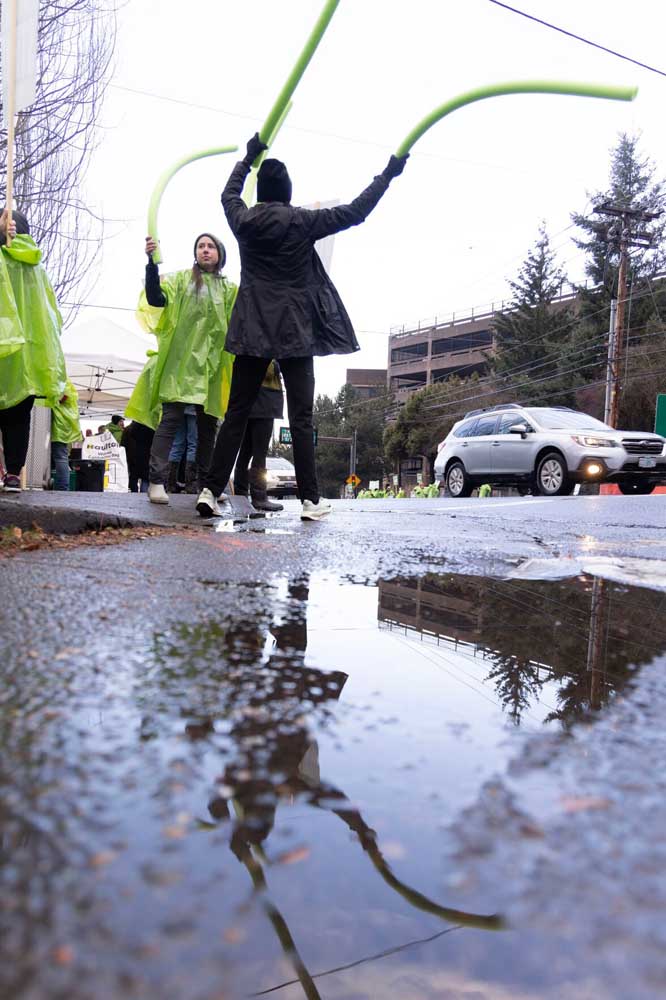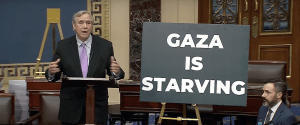Nurses, physicians out in force as strike begins at Providence St. Vincent
Published 3:30 pm Friday, January 10, 2025

- Melissa Clifford (left) and Andrea Kaleshnik, both nurses who work in cardiology at Providence St. Vincent Medical Center, wave pool noodles along Southwest Barnes Road to take part in a nurses strike Jan. 10 in Beaverton.
(This story updates the number of ONA-represented nurses who have chosen to work during the strike.)
Trending
Dozens and dozens of nurses (and some physicians as well) lined Barnes Road Friday morning, Jan. 10 — in front of and across the street from Providence St. Vincent Medical Center — holding picket signs on the first day of the largest health care strike and first physician strike in Oregon history.
In all, the strike includes an estimated 5,000 frontline health care workers across the state from 11 Providence bargaining units. The nurses strike includes not only St. Vincent and Providence Portland Medical Center on Northeast Glisan Street, but also those medical centers in Newberg, Milwaukie, Oregon City and throughout the state.
Among those out on the picket line Friday was St. Vincent critical care nurse Lisa Gregory, who said she was pleased with having such a large turnout on such a rainy and cold morning.
Trending
Gregory has worked at Providence St. Vincent for more than 25 years and is part of a bargaining unit for the Oregon Nurses Association.
She said she doesn’t believe nurses are any closer in finding a solution to the strike, which includes an estimated total of 1,875 at St. Vincent alone.
“We are still looking for decent market wages, better health benefits, because we pay a lot in deductibles. Our health benefits are the worst out of all the hospitals, and we’re employees of a hospital. We’re also looking for better (paid) time off,” said Gregory, a Lake Oswego resident.
Also standing on a corner across from the hospital holding signs were nurse mother and daughter duo Tina Moore and Mallery Siliga.
“There’s more competitive wages at other hospitals like (Oregon Health & Science University),” said Siliga, a Beaverton resident who has been a St. Vincent orthopedic nurse for four years. “We want to retain our skilled nurses, but why would you stay if you can get paid better somewhere else with better staffing and better health care?”
Moore, who doesn’t work for Providence but spent 17 years as a nurse in the Oregon City School District, said it’s important to realize that nurses are picketing because of issues pertaining to better patient staffing.
Also out in the morning rain was Dr. Charlie Saltalamacchia, an OB/Gyn physician at St. Vincent.
“The reason we’re out here on strike is because of the long term. We really want the patients to get the care that they deserve, and that involves getting the resources that they need, which is safe staffing and fair nurse wages and having people be retained and recruited for sustainable care for a long time,” said Saltalamacchia, an attending physician at the hospital since 2015. “I think we have a lot of passionate health care workers here who love what they do, love taking care of patients, and want to have the resources that they need to keep doing that for a long time.”
According to Providence officials, the only places some physicians are on strike are at Providence St. Vincent and Providence women’s clinics. The strike does not include physicians such as surgeons, emergency room doctors or specialists at those locations.
Jennifer Lincoln, an OB/GYN physician was on the picket line as well.
“We’re hoping that Providence sees that doctors and nurses are standing together to get safe staffing, to show executives that they need to listen to the people who are caring for the patients and that we are a top 50 hospital because of the people who work here, not because of corporate executives,” she said.
Among those nonmedical trained area residents attending the strike was Tim Kasal, a carpenter from Hillsdale who said he decided to stand with the nurses instead of going to work today. Kasal credits the St. Vincent nurses with saving the lives of both his daughter, Shelby Taylor, and her now-2.5-month-old son, Chase. Kasal said his daughter, a Tualatin resident, had preeclampsia, and spent seven weeks in the hospital. His grandson was there for two months in the NICU.
Kasal praised the nurses not only for helping out from a medical-knowledge standpoint but also for “the gift that they have of loving the patients and everything means just as much as the medical end, if you ask me. I got to witness, you know, we all take that type of care for granted until it happens to your family and then you see the miracle they created.”
However, on Friday afternoon, Providence officials pushed back on several issues pertaining to the nurses and physician strikes during a news conference at Providence Office Park in Portland.
“The union leaders who called this strike did so with the intent of disrupting patient care — especially at Providence St. Vincent and our women’s clinics, where some physicians have chosen to strike,” Jennifer Burrows, chief executive of Providence Oregon and a registered nurse, said in a statement.
She said 2,000 temporary replacement nurses had been hired.
Dr. Ben LeBlanc, chief executive of Providence Medical Group Oregon, said things were going well on the first day of the strike at both St. Vincent and Providence women’s clinics with those temporary nurses having received intensive Providence orientation over the last several days.
“At Providence St. Vincent Medical Center, where approximately 70 hospitalist physicians have gone on strike, is also operating smoothly this morning,” he said in a statement.
One key point regarding the nurse’s strike, according to Providence officials, is that one of the offers on the table includes a 20% raise for acute-care RNs (whose salaries average $125,000 annually) with a double digit pay increase after contract ratification. That’s before overtime, holiday pay or other incentives.
On Monday, Providence announced that more than 600 ONA-represented nurses have chosen to work. That is a rate nearly 400% higher than in previous strikes, Providence officials pointed out.







